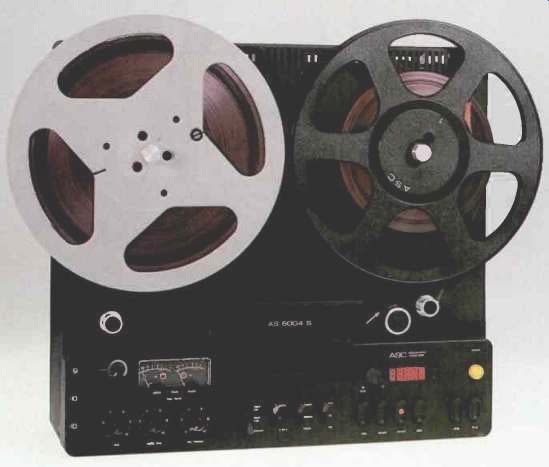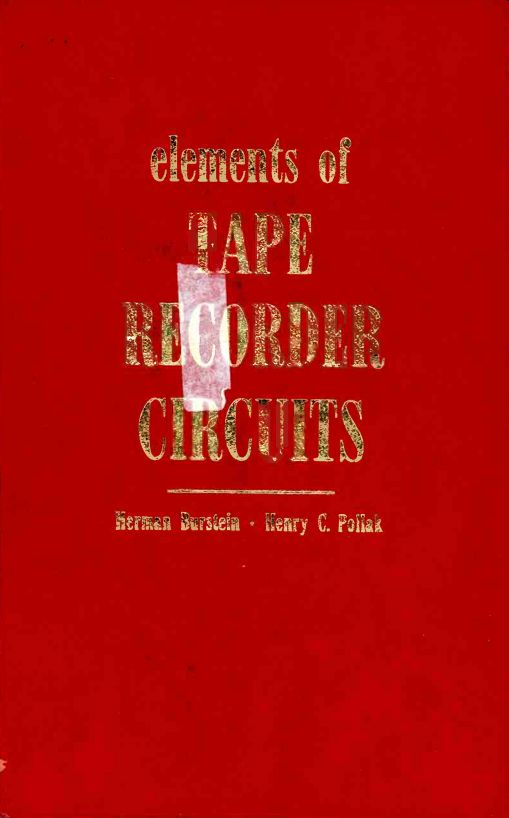
Contents
- Elements of a tape recorder
- Characteristics of a high-quality tape amplifier
- Head characteristics
- Tape characteristics
- Bias current
- Equalization requirements
- Equalization circuits
- Oscillators
- Record-level indicators
- Minimizing noise and hum

THIS guide is intended for the audiophile as well as the technician interested in the tape recorder; for the audiophile who wants to know "what makes it tick" and for the technician who wishes to approach a tape recorder not only with instruments and a schematic but also with a secure understanding. Comprehension of the factors that enter into the design and operation of a tape machine enables a purchaser to select wisely from the available units and to obtain the best possible recording results: it enables the service technician to insure that a tape recorder yields the performance designed into it.
It is assumed that the reader has an elementary knowledge of electronics and audio such as may be readily acquired from some of the popular and readily assimilable books on the market.' If he has a rudimentary understanding of electricity and magnetism, of audio terminology and the fundamental building blocks of electronic circuits-resistors, capacitors, inductors, vacuum tubes and transformers--he is equipped to follow the discussion. Even the reader who lacks this background should find much that gives him a clearer picture of what is underneath the surface of tape recorders.
In substantial part, the guide is written from the design view point. It should be quickly added that this is not a text for de signers of tape recorders. Rather, it seeks to explain circuitry in terms of what the designer is trying to accomplish. To the extent that circuits are analyzed in certain sections, the purpose is not an exercise in circuit analysis but to uncover fundamental principles. A grasp of principles will equip the reader to understand many more circuits than these pages hold room for.
To understand the tape recorder it is not enough to comprehend the basic ideas at work. It is necessary to examine the problems that have led to their evolution. The problems remain latent and rise to plague the user or technician when the tape recorder mal functions because of wear, misalignment, abuse, etc. Stated differently, it is desirable to know not only what makes a tape recorder work satisfactorily but also what makes it work unsatisfactorily.
Side by side with electronic problems there is the ever-present question of cost. Economy generally dictates the course that the designer must follow. A given electronic problem may have several solutions with varying degrees of merit, but cost may prevent the designer from using that which he considers best. Here, then, is one of the most important factors accounting for substantial differences among tape recorders. In a rough way, one may differentiate between "moderate-price" tape recorders on the one hand, selling for less than $300, and professional and semi-professional units on the other hand, priced from $300. The following sections attempt to give due space to each class of recorder.
As a means of directing attention to good practice, the discussion is likely to focus somewhat more on the circuits and principles exemplified in the better units.
An appreciation of tape recorder problems, principles and practices is not a matter of mere academic interest. There are very practical advantages to such knowledge. The reader can expect this knowledge to serve him well in extracting the best possible performance from his machine. Moreover, many a technically minded audio hobbyist eventually becomes concerned with the design viewpoint when he finds himself dissatisfied with some function, circuit or facility of his recorder and wishes to improve upon it, possibly to the extent of rebuilding a substantial portion.
Here one may draw a parallel with the extensive alterations which audiophiles perform upon such equipment as audio amplifiers and preamplifiers. Numerous articles have been written on changes intended to improve the performance of these units. As the audiophile grows more at home with the tape recorder, he may similarly wish to try his hand at improving its performance.
In the interest of maximum clarity, mathematics will be avoided as an explanatory device, with very few exceptions where no more than elementary arithmetic is used to make an important point clear. In most instances, the discussion can be offered in commonsense terms. Where only mathematics of a fairly high level can prove a point, the reader's acceptance of an unproven statement will have to rest upon his confidence in the authors.
The terms amplifier, tape amplifier, record amplifier and play back amplifier will appear frequently. To avoid possible mis understanding, it should be made clear at the outset that these do not include the audio power amplifier often found in tape recorders, particularly in moderate-price machines. Explicit use will be made of the phrase "power amplifier" when the discussion is concerned with this item.
Scope of the guide
A tape recorder consists of two basic parts-mechanical (the transport mechanism) and electronic. This guide is concerned with the latter, the term being used here in a broad sense to include everything other than transport. The subject of transports is sufficiently important and complex that another volume would be required to do justice to it. Therefore, only a cursory review of the functions and elements of a transport mechanism will be attempted. To the extent that the transport creates problems of an electronic nature-for example, noise on the tape-due attention shall be paid to it.
It is difficult to draw a clear physical line between the electronics and the transport. Certain electronic elements are often mounted on the transport so that electronic and mechanical functions may be controlled simultaneously, or for other reasons.
And, of course, the heads are mounted on the transport mechanism. It should be explicit from the viewpoint of this guide that the electronics includes not only the amplifier but also the heads and the tape.
The various sections are concerned with the electronic functions of the tape recorder, why these functions are called for and the means of performing them. To provide perspective, the recorder is first pictured in context, that is, as part of a complete audio system. Behavior of the heads and the tape is examined.
The fundamental problems of frequency response, distortion and ... noise are dealt with in terms of design and of extracting optimum performance from a given recorder. Requirements for high-quality performance are given. Basic circuitry is described and evaluated.
-----------------
Since the preamplifier is an integral part of the amplifier, it will not be considered as a separate unit. The term amplifier will be understood to include preamplifier.
----------------
There are many special types of tape recorders, such as those used for industrial testing, electronic computing, scientific measurement, video recording, motion-picture recording, etc. No at tempt is made here to cover these, which merit extensive but separate discussion. The fundamental concern of this volume is with tape recorders, either of the professional or moderate-price variety, commonly employed for audio recording and reproduction, especially in home music systems. All tape recorders share certain common principles so that the present discussion is of value to the reader interested in tape recorders used outside the field of audio.
In dealing with a subject such as the tape recorder, it is possible to expand in many directions. Thus, one could write on the nature of sound, on music, on the manifold uses for audio tape recorders, on the art of tape editing, on microphone techniques.
These topics are not treated here. Not that they lack importance, but it is the desire of the authors to concentrate on the purpose at hand, which is to explain the electronics of the tape recorder.
In this guide the authors seek to explain how tape recorders work, how desired objectives are attained through appropriate design. They have been very conscious of the practical side of the matter and have focused more on recorders as they are than as they ought to be. As a result they have acquired a debt of gratitude to various manufacturers who have supplied schematics, photographs, charts, and other materials for this guide. Among these are Ampex Audio, Inc., Audio Devices, Inc., Brush Electronics Company, Concertone [American Electronics, Inc.], Dynamu Magnetronics Corp., Magnecord, Inc. [Div. Midwest Instruments Co.], Minnesota Mining & Mfg. Co. [3-M Co.], Pentron Corp., Presto Recording Corp., Shure Brothers, Inc., Viking of Minneapolis and Wilcox-Gay Corp.
Although the entire text of this guide is new, the authors have depended in several sections upon materials appearing in magazine articles previously written by them. Accordingly they wish to thank Audio and Radio & TV News for permission to use charts, tables, and other data which appeared in these articles.
HERMAN BURSTEIN; HENRY C. POLLAK
---------
John T. Frye, Basic Radio Course; Donald Carl Hoefler, Basic Audio Course, (Gernsback Library, Inc.); David Fidelman, Guide to Audio Reproduction, (John F. Rider Publisher, Inc.).
-------------
Also see:
Tape Recorders--How They Work (Sams; 1956)